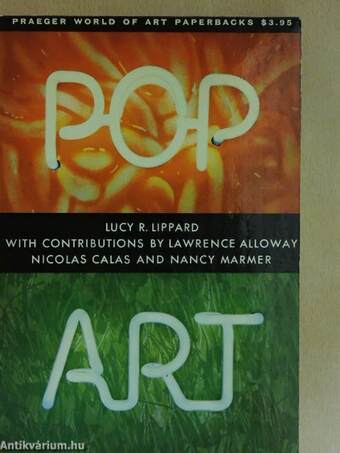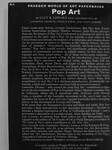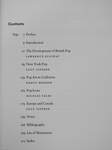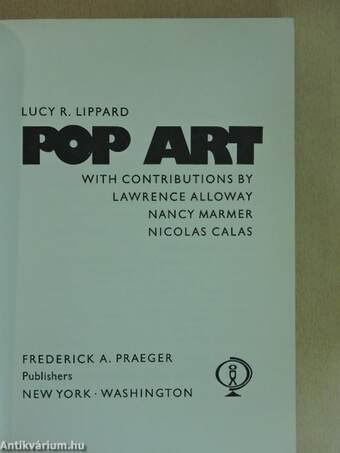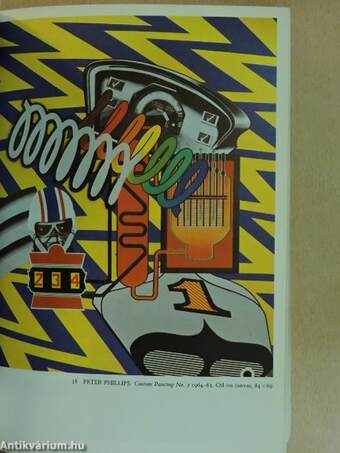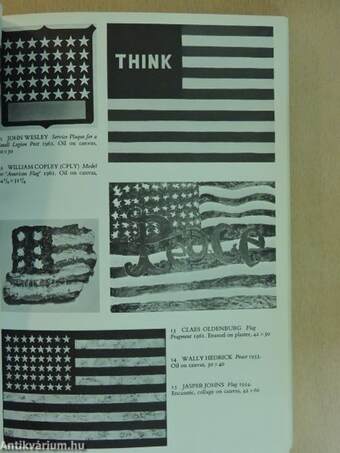1.067.309
kiadvánnyal nyújtjuk Magyarország legnagyobb antikvár könyv-kínálatát

VISSZA
A TETEJÉRE
JAVASLATOKÉszre-
vételek
Pop Art
| Kiadó: | Frederick A. Praeger |
|---|---|
| Kiadás helye: | New York |
| Kiadás éve: | |
| Kötés típusa: | Ragasztott papírkötés |
| Oldalszám: | 216 oldal |
| Sorozatcím: | Praeger World of Art Paperbacks |
| Kötetszám: | 210 |
| Nyelv: | Angol |
| Méret: | 21 cm x 14 cm |
| ISBN: | |
| Megjegyzés: | Színes és fekete-fehér fotókkal. |
naponta értesítjük a beérkező friss
kiadványokról
naponta értesítjük a beérkező friss
kiadványokról
Fülszöveg
PRAEGER WORLD OF ART PAPERBACKS
PuD Art
by LUCY R. LIPPARD with contributions by
_ lawrence alloway, nicolas calas, and nancy marmer
Giant comic-strip heroes, oversize frankfurters; Ben Day dots, Kandy Kolors, brand-name products; Marilyn Monroe, John Wayne, pin-ups: these are the images of Pop Art. Condemned as a passing fad since it first appeared in the early 1960's, Pop Art has become a cause célebre in the United States and abroad, the recipient of lavish praise, and virulent abuse. An art movement as native to America as the Ashcan School, the product of America's "long-finned, big-breasted, one-born-every-minute society," Pop Art's central novelty and significance, perhaps, Îies in its sanction of commercial products as subject matter. In Pop Art, Lucy Lippard and three noted critics - all of them on-the-scene witnesses -trace the spectacular growth of Pop. In the introduction, Lucy Lippard examines Pop's precursors and related styles, ranging from folk art, Surrealism,... Tovább
Fülszöveg
PRAEGER WORLD OF ART PAPERBACKS
PuD Art
by LUCY R. LIPPARD with contributions by
_ lawrence alloway, nicolas calas, and nancy marmer
Giant comic-strip heroes, oversize frankfurters; Ben Day dots, Kandy Kolors, brand-name products; Marilyn Monroe, John Wayne, pin-ups: these are the images of Pop Art. Condemned as a passing fad since it first appeared in the early 1960's, Pop Art has become a cause célebre in the United States and abroad, the recipient of lavish praise, and virulent abuse. An art movement as native to America as the Ashcan School, the product of America's "long-finned, big-breasted, one-born-every-minute society," Pop Art's central novelty and significance, perhaps, Îies in its sanction of commercial products as subject matter. In Pop Art, Lucy Lippard and three noted critics - all of them on-the-scene witnesses -trace the spectacular growth of Pop. In the introduction, Lucy Lippard examines Pop's precursors and related styles, ranging from folk art, Surrealism, Dada, Stuart . Davis, and Léger to the Reuben group, and Assemblage, Robert Rauschenberg, and Jasper Johns. She then writes of Pop Art in New York, laying emphasis on the five hard-core Pop artists: Warhol, Lichtenstein, Wesselmann, Rosenquist, and Oldenburg. The images they depict are all For Sale: Campbell's soup cans, comic strips, canned spaghetti, hamburgers. Life filtered through them "bears little resemblance to real life;" it is deadpan reproduction, determinedly optimistic, a fresh and sometimes uncritical look at our environment. Lawrence Alloway - who coined the term Pop Art - contributes a chapter on the development of Pop in England; Nancy Marmer considers Pop in California, where she is associated with Artjorunr, critic Nicolas Galas, a member of the Surrealist movement in the 1930's and 1940's, appraises the icons of Pop; and Lucy Lippard concludes with a sweeping survey of the movement in Europe and Canada.
With more than 180 illustrations in color and black and white. Pop Art provides a basic introduction to this important movement - the first to include a detailed exploration of Pop in California and Europe - and a provocative discussion of a controversial, often dazzling art form.-the author: At present New York editor for Art International, Lucy Lippard is the author of The Graphic Work of Philip Evergood, co-author of The School of Paris, and a contributor to Tin New Art. '
the contributors: Lawrence Alloway, Curator of the Solomon R.Guggenheim Museum, 1962-66, is an advisory editor for Art International, an art critic, lecturer, and teacher. Nancy Marmer has been Los Angeles editor for Art International. Nicolas Calas is the co-author of The Peggy Guggenheim Collection and of Primitive Heritage.
cover designed by James Rosenquist, photograph byMelvin Sokolskj
A complete catalog of Praeger World of Art Paperbacks currently in print will be sent at your request Vissza
Témakörök
- Idegennyelv > Idegennyelvű könyvek > Angol > Művészetek > Művészettörténet, általános
- Művészetek > Művészettörténet általános > Idegen nyelv > Angol
- Művészetek > Művészettörténet általános > Művészettörténet > Külföldi
- Művészetek > Művészettörténet általános > Korszakok, stílusok > XX. század > Egyéb
- Művészetek > Művészettörténet általános > Összefoglalók > Nemzetközi > Egyéb
Lucy R. Lippard
Lucy R. Lippard műveinek az Antikvarium.hu-n kapható vagy előjegyezhető listáját itt tekintheti meg: Lucy R. Lippard könyvek, művekMegvásárolható példányok
Nincs megvásárolható példány
A könyv összes megrendelhető példánya elfogyott. Ha kívánja, előjegyezheti a könyvet, és amint a könyv egy újabb példánya elérhető lesz, értesítjük.



